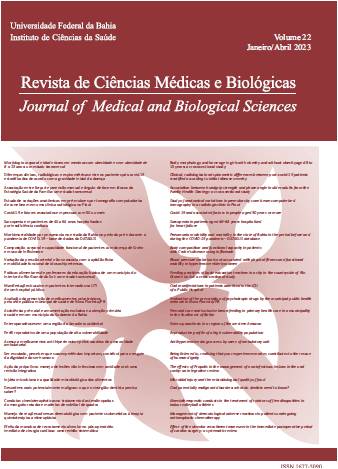Manifestações bucais em pacientes internados na UTI de um hospital público
DOI :
https://doi.org/10.9771/cmbio.v22i1.49817Mots-clés :
Unidades de Terapia Intensiva, Manifestações Bucais, Higiene Bucal, Equipe Hospitalar de Odontologia, Mucosa Bucal.Résumé
Introdução: durante a permanência em Unidades de Terapia Intensiva (UTIs), os pacientes internados apresentam maior vulnerabilidade a alterações na cavidade oral decorrentes do uso de equipamentos de respiração artificial e do estado imunocomprometido em que se encontram. Objetivo: identificar as principais manifestações bucais em pacientes internados em uma UTI bem como verificar o conhecimento dos profissionais responsáveis pela higienização bucal. Metodologia: trata-se de um estudo quantitativo descritivo com delineamento transversal. Os dados foram obtidos nos prontuários médicos dos pacientes e através de um exame clínico intraoral. Para os profissionais responsáveis pela higiene bucal, foi utilizado um questionário. As análises foram realizadas no programa SPSS versão 21.0 de forma descritiva. Resultados: as manifestações bucais com maior incidência foram saburra lingual, biofilme dentário, candidíase, devido a qualidade da higiene bucal prestada e a baixa imunidade. Os achados bucais e sistêmicos relacionados aos pacientes com maior tempo de internação foram ressecamento labial, queilite angular, língua despapilada, candidíase e pneumonia. Todos os profissionais responsáveis pela higienização bucal dos pacientes tinham formação técnica em enfermagem e desconheciam alterações importantes como biofilme dentário e pneumonia nosocomial. Conclusão: os dados deste estudo permitem concluir que apesar da constância com que é realizada a higienização bucal, verifica-se alta frequência de lesões bucais nos pacientes críticos da UTI. Evidenciando o papel da assistência da higienização bucal de qualidade, destacando a importância da atuação do cirurgião dentista em equipes multiprofissionais, visto que o risco de focos infecciosos bucais pode contribuir para o agravo e piora do quadro clínico dos pacientes.
Téléchargements
Téléchargements
Publiée
Comment citer
Numéro
Rubrique
Licence
(c) Tous droits réservés Revista de Ciências Médicas e Biológicas 2023

Ce travail est disponible sous la licence Creative Commons Attribution 4.0 International .
A Revista de Ciências Médicas e Biológicas reserva-se todos os direitos autorais dos trabalhos publicados, inclusive de tradução, permitindo, entretanto, a sua posterior reprodução como transcrição, com a devida citação de fonte. O periódico tem acesso livre e gratuito.






